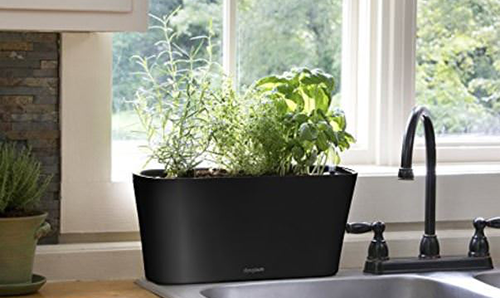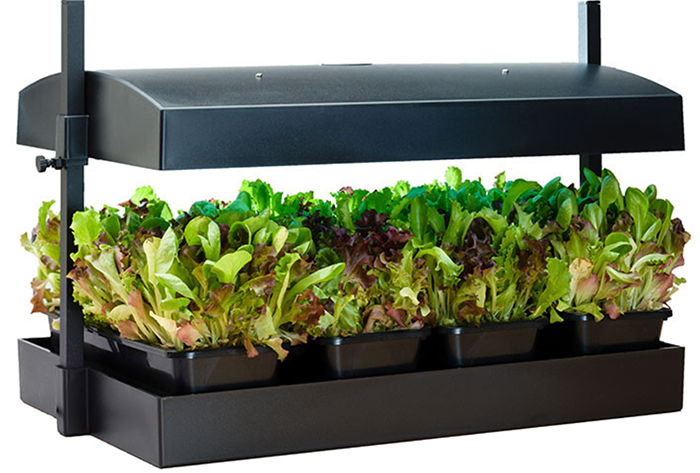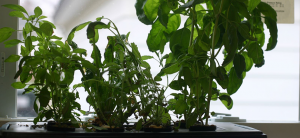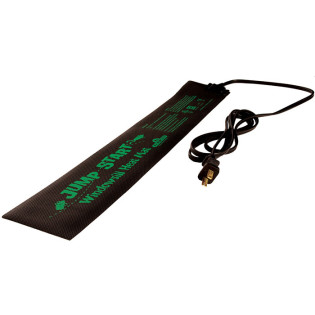
At first glance, the idea of a kitchen garden may seem sort of odd. Whether you already have an herb garden or not, why would you want to grow things in your kitchen? Doesn’t a garden take up a lot of space, how would that even work?
The reality is that anyone who has a little counter space can start growing produce in their kitchen. We’ll cover the specifics of this later on, and give you a step by step guide on how to get started.
But first, let’s explain why a kitchen garden might make sense for you.
Why you need your own kitchen garden

Picture this - it’s Friday night, and you’re making a pizza. You reach into your spice rack for a jar of basil to garnish your crust, just to find you’re fresh out.
Not to worry, though. You can simply reach over to your windowsill herb garden, pluck a few fresh leaves, and sprinkle them over your creation.
If that sounds like pure and utter fantasy, rest assured - it’s not. When you grow herbs in the kitchen, you’ll be able to use fresh, organic herbs at any time of the day, allowing you to add both zest and personality to your dishes.
You really can't get any fresher than plucking cilantro leaves off your plant on the counter, and putting them directly into your tacos!
Benefits of an Indoor Kitchen Garden
There are lots of reasons to grow your own kitchen garden - many of them with which you are already probably quite familiar.
Not only can maintaining a simple countertop kitchen serve as an enjoyable pastime, but it’s also incredibly affordable.
A packet of seeds is usually less than $3, meaning you can start dozens of plants for pennies apiece. It’s also simple.
There’s a misconception that maintaining a garden is a lot of work. This couldn’t be further from the truth - at least, not when you’re growing in the kitchen.
A little bit of maintenance here and there, and you’ll have all the fresh herbs you could ever possibly want.
Plus, who doesn’t appreciate the delicate, simple beauty of a row of lush, green herbs lining the windowsill?
Now that you’re sold on the idea of your own kitchen gardening operation, let’s explain how you can get started on a budget.
How to start your own kitchen garden

Starting your own garden in the kitchen is not much work at all, but if you want to see success your first time, you need to follow some steps carefully.
You need to plan it out strategically, especially considering your space is likely going to be really limited.
Then, you need to grab the right supplies and plant your seeds or head to your local nursery and grab your plants.
From there, its just a matter of maintaining the garden, and enjoying the fruits of your labor!
What Kinds of Plants Will You Grow?
Your first step in setting up the ultimate kitchen garden is deciding what to grow. While you don’t have to limit yourself to just herbs, many people go for herbs in their kitchen gardens for a number of reasons.
First off, herbs are easy to grow. They don’t require a lot of attention and are more or less self-sustaining.
They grow well indoors, as they like the calm, moderate temperatures you might find in a house.
Plus, you can harvest most herbs on an ongoing basis, meaning you can keep a kitchen garden of herbs going year-round.
Your options are limitless, but you might want to consider choices like:
- Basil
- Chives
- Marjoram
- Parsley
- Oregano
- Rosemary
- Thyme Sage
- Mint
- Lemon balm
How to start your seeds
Starting seeds may sound like a daunting task, but its pretty simple. Seeds need just a few things in order to sprout: heat & moisture.
Many growers are able to germinate seeds on their windowsill by using just a moist paper towel. The sun will provide enough warmth, while the wet paper towel saturates your seeds with water, forcing them to "pop".
You can learn more about this process in our complete guide to germination.
How will you grow your herbs - soil vs hydroponics

When you are growing any kinds of plants indoors, you will have two options available to you in how you choose to set the kitchen garden up.
You can grow in a hydroponic system (in water) or you can grow in a traditional soil setup.
Growing in soil might sound like the better option, because its cheaper. All you really need is soil and a small planting bed or container.
You may choose to purchase things like soil amendments and nutrients, too, although these aren’t usually necessary for small indoor herb gardens.
To be honest, though, soil may not be your best bet. It is a great way to grow both indoors and outdoors, but as you can imagine, it isn’t well suited for your kitchen.
The last thing you want is dirt on your countertops. And, soil invites many pests into your kitchen, which is another no-no when it comes to preparing food.
That's why many people grow hydroponically in their kitchen.
Why a hydroponic kitchen garden makes the most sense
If you decide to grow hydroponically, you’ll have a bit more of an investment upfront.
However, once you get things going, you’ll enjoy much less work and higher yields.
Most importantly, though, your kitchen countertops will remain clean, and many of the pests soil invites will have no desire to touch your garden.
A hydroponic system involves growing plants in water or some kind of soilless medium.
Both nutrients and water are delivered directly to the plant’s roots, which can lead to mindblowing growth.
Prebuilt hydroponic systems for kitchen gardening
If you want to keep things simple, we recommend using a system made specifically for kitchen gardening.
We have a couple of hydroponic microgarden kits at Hydrobuilder. These come with everything you need to start your hydroponic kitchen garden. Here are a few of our favorites:
Getting light to your plants & the ideal environment
Its important that you place your hydroponic system or container near a windowsill so the plants can get light throughout the day.
For best results you will need to place your herbs in a sunny spot near a south-facing window. Make sure they get at least six hours of sun each day.
If you’re growing plants that don’t require quite as much light, like parsley and mint, you can also settle for a westward-facing window.
It’ll be very obvious if your plants aren’t getting enough light. They might suffer from poor growth or have stems that are unusually long between the sets of leaves.
Stretching like this indicates your plants are starving for light, and are reaching towards the sky.
The leaves might also yellow or turn pale. It’s not just light that you need to think about, though. You will also need to consider how drafty the location is.
Plants that are exposed to drafts won’t grow as well and can easily become dried out, too. As long as your plants are around 65 to 70 degrees, they will be comfortable.
Just remember that the air next to a window will be both cooler in the winter and hotter in the summer, so you may need to adjust your watering conditions accordingly.
Using grow lights and a heat mat
If you are worried your plants wont get enough light, or that they’ll become too cold during winter months, there are products to help you create the ideal conditions: grow lights & heat mats
Small LED or fluorescent grow lights are a great way to provide optimal lighting to your plants. There are small lights that can illuminate your garden in an affordable manner.
In fact, some of the hydroponic kitchen garden kits we mentioned earlier include a small grow light!
You can also put a heat mat under your plants during germination or the winter to keep the temperature where it needs to be, and allow your plants to thrive.
Maintenance & care for your kitchen garden
Depending on what types of plants you are growing, there really won’t be much to do. If you are growing hydroponically, your main responsibilities will be in relation to the system.
You’ll need to monitor conditions in your water, and ensure the system is always topped off with nutrients as needed.
Be sure you research the specific growing requirements of each of your individual plants as you’re getting started.
Thankfully, traditional chores like pest control and weeding are typically eliminated in an indoor growing environment.
Final thoughts on growing in your kitchen
Now that you know how easy it is to start your own kitchen garden, you can start shopping for seeds and supplies and become more self sustainable than you were before!
If you are thinking you may want to learn more about indoor growing in general, check out our complete guide.
You may end up deciding you want to start a larger indoor garden, in which case that guide will come in handy. But, you’ll need a grow tent kit for that, along with much more maintenance and care.
If you have any questions about starting your garden, reach out to our experts at 888-815-9763 or by email here.




















